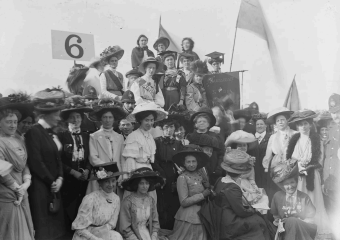March is Women’s History Month. To celebrate the wonderful achievements that women have made in society, let’s take a closer look at the suffrage movement in Britain—perhaps the most iconic fight for women’s rights in the 20th century. Starting from the 1800s until 1918, when women over 30 received their right to vote, two groups—the National Union of Women’s Suffrage Societies (NUWSS) and the Women’s Social and Political Union (WSPU)—attempted to reform the misogynistic voting system in their country. These women, each called suffragists and suffragettes, had different methods of expressing their frustrations, yet shared the same objectives.
Before the movement officially began, men and women were treated very differently. Women were expected to follow the traditional gender role of taking care of domestic matters while lacking protection from abuse and violence. The Industrial Revolution did allow working-class women to work, but they were paid and treated poorly. Advanced education was a rare case. Still, early attempts to reform the voting system arose during these times. John Stuart Mill, a renowned philosopher and a member of Parliament, proposed an amendment that argued for universal suffrage after accepting a petition from women. Unfortunately, as expected, it was defeated by a large margin. The significance, however, was that his effort led to the creation of a new organization called the London Society for Women’s Suffrage.
More and more people began to join them, leading to the formation of the National Union of Women’s Suffrage Societies. Led by the first female doctor in the UK, suffragists mainly focused on the non-violent side of the movement. This included signing and starting petitions, putting up posters, and organizing peaceful marches. Despite their efforts, however, there was limited progress. More and more women were starting to get frustrated and realized more firm actions were needed to display their beliefs to the world.
In 1903, the Pankhursts—Emmeline, Christabel, and Sylvia—formed the Women’s Social and Political Union. Their motto, “deeds not words,” demonstrates what their members, the suffragettes, believed in. Rather than being dependent on others for change like the suffragists were, they decided to take matters into their own hands. Over 1,300 women were imprisoned for various reasons, such as bombing and burning down buildings, chaining themselves to places like Buckingham Palace, and smashing windows. It wasn’t over for them after they were locked inside the cells. Some women went on hunger strikes, causing the government to feed them forcefully in a dangerous way. One suffragette named Emily Davison was fatally injured after crashing into a horse owned by King George V during a derby as a protest for voting rights.
The suffragettes’ fight abruptly halted as World War I broke out in 1914. They decided to support their nation during wartime, and all prisoners arrested for the suffrage movement were released. Four years later, what they had dreamt of was finally realized to some extent: women over 30 gained the right to vote despite some restrictions. Gradually, other countries also granted women suffrage. And as Emmeline Pankhurst said, suffragettes were there to be lawmakers, not law-breakers.
Works Cited
“Birth of a Movement.” Historic England,
historicengland.org.uk/research/inclusive-heritage/womens-history/suffrage/birth-of-a -movement/. Accessed 13 Mar. 2025.
“The Creativity of Protest.” Historic England,
historicengland.org.uk/research/inclusive-heritage/womens-history/suffrage/creativity -of-protest/. Accessed 13 Mar. 2025.
“The Suffragette Movement.” BBC Bitesize, BBC, 31 Jan. 2022,
www.bbc.co.uk/bitesize/articles/zh6nsk7.
“The Suffragettes.” London Museum,
www.londonmuseum.org.uk/collections/london-stories/the-suffragettes/. Accessed 13 Mar. 2025.
“Who Was the Suffragette Emily Davison?” London Museum,
www.londonmuseum.org.uk/collections/london-stories/who-was-suffragette-emily-da vison/. Accessed 13 Mar. 2025.
“Why Did Suffragettes Go on Hunger Strike?” London Museum,
www.londonmuseum.org.uk/collections/london-stories/why-did-suffragettes-go-on-hu nger-strike/. Accessed 13 Mar. 2025.
“Women’s Struggle for the Right to Vote – the Fight for Female Suffrage – KS3 History – Homework Help for Year 7, 8 and 9. – BBC Bitesize.” BBC News, BBC, 25 Oct. 2023, www.bbc.co.uk/bitesize/articles/z6gh6g8.
By. Yeseo Kwak


